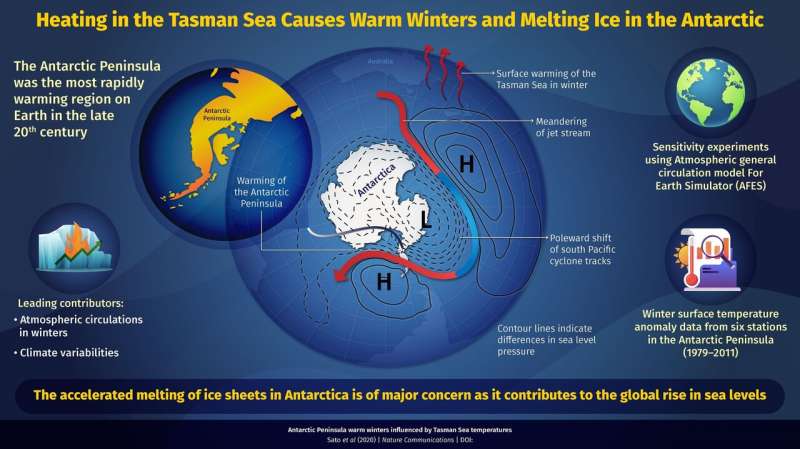Antarctic Peninsula warming up due to heat in Tasman Sea

The melting of the Earth's ice cover intensified in the 20th century, with glaciers and sea ice in the Arctic and Antarctic regions melting at alarming speeds. In fact, The Antarctic Peninsula (AP), which is the only landmass of Antarctica extending out past the Antarctic Circle, was found to be one of the most rapidly warming regions on the planet during the second half of the 20th century. This rapid change in climate has raised serious concerns of rising sea levels the world over.
Multiple factors have been associated with the melting of the ice cover: the primary factor being the greenhouse gas emissions from human activities that cause warming up of the atmosphere and the oceans and the consequent ice melting. Apart from this, atmospheric variations, ocean currents, and wind patterns also play a significant role. Now, a collaborative group of scientists from Japan and Australia—led by Assistant Professor Kazutoshi Sato from Kitami Institute of Technology and Associate Professor Jun Inoue from National Institute of Polar Research in Japan—has focused efforts on understanding how fluctuations in these climatic factors affect the warming of the Antarctic. They have documented their findings in a brand-new article published in Nature Communications.
Previous studies have examined the relationship between the wind dynamics over the Southern Ocean (also called SO; located north of Antarctica) and climate variability in tropical oceans. It was found that heating in tropical regions generates atmospheric waves called "Rossby wave trains" from the tropics to the Antarctic region via the SO, which causes heating of the West Antarctic region. Interestingly, Rossby waves are an attempt of nature to balance heat in the atmosphere as they transfer heat from the tropics to the poles and cold air towards the tropics.
On the path of understanding the warming of AP, Dr. Sato points out, "The impacts of climate variabilities over the mid-latitudes of the Southern Hemisphere on this Antarctic warming have yet to be quantified." His team addressed this gap by looking at the climate changes in the Tasman Sea located between Australia and New Zealand and the SO and drew correlations with temperature variations in the AP.
Dr. Sato and his team analyzed the temperature data from six stations in AP and the wind and cyclone patterns over the Tasman sea and the SO from 1979 to 2019. They found that even without unusual heating in the tropics, only the heating in the Tasman Sea modifies the wind patterns over the SO and forces the Rossby waves to move even deeper into the Amundsen sea low, a low-pressure area lying to the west of the AP. This larger pressure gradient causes stronger colder winds towards the poles. The meandering wind stream moves towards the AP, resulting in the warming of this region. Additionally, this effect was found to be prominent in the winter months when the cyclones are more active. "We have shown that warm winter episodes in the Tasman Sea influence warm temperature anomalies over key regions of West Antarctica, including the AP, through a poleward shift of South Pacific cyclone tracks," Dr. Sato summarizes.
The ever-increasing warming of the AP—and the whole of Antarctica at large—is a major concern plaguing climatologists all over the world. Commenting on the serious implications of this rapid rise in temperature and sea levels and the importance of the findings of their study, Dr. Inoue says, "Antarctic warming accelerates Antarctic ice sheet melting and contributes to the rise in sea levels across the world. Therefore, knowledge of the mechanisms of the melting of the Antarctic ice sheet would help scientists, policymakers, and administrations to devise measures for people who will be most affected by the rising sea levels."
Dr. Sato and his team concludes by stating that the findings of their study can also aid the future forecast of ice sheet melting in Antarctica and consequent global sea level rise.
More information: Kazutoshi Sato et al, Antarctic Peninsula warm winters influenced by Tasman Sea temperatures, Nature Communications (2021). DOI: 10.1038/s41467-021-21773-5
Journal information: Nature Communications
Provided by Research Organization of Information and Systems





















